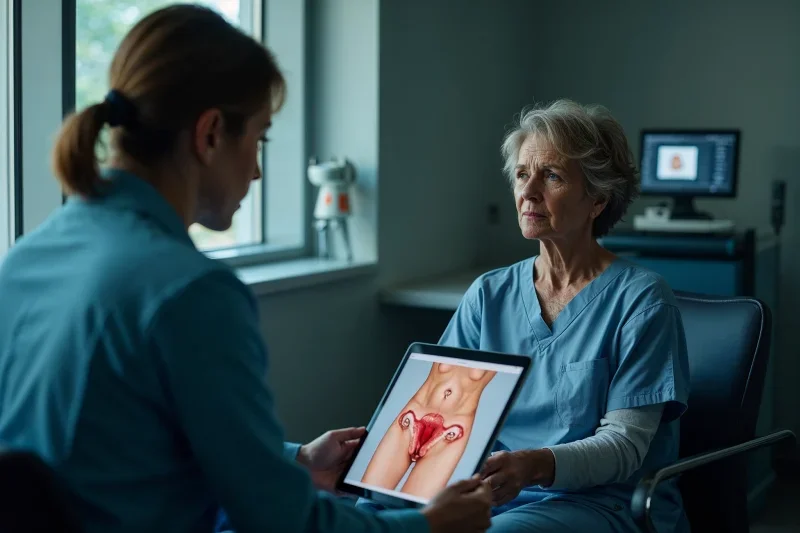Overcoming Post-Operative Discomfort: Tips and Strategiesa
Categories:
By: Ethan Cole
Understand the types of post-surgery pain and prescribed medications to manage them effectively.
Time medication intake properly and learn to handle any side effects for optimal pain management.
Incorporate natural remedies such as herbal alternatives and gentle exercise techniques for additional pain relief.
Engage in tailored physical therapy techniques to improve strength, flexibility, and overall recovery.
Practice mindfulness and maintain a nutritious diet to aid healing and manage discomfort.
Introduction
Managing post-operative discomfort requires a comprehensive understanding of the various types of pain, effective management of medication, and the incorporation of natural remedies such as herbal alternatives. Engaging in gentle exercises can also play a significant role in recovery. The importance of physical therapy techniques and dietary modifications should not be overlooked, as they can greatly support the healing process. Practicing mindfulness can aid in controlling thoughts and emotions, thereby reducing anxiety during recovery. Addressing each of these elements can contribute to a smoother post-surgery experience. Adopting a step-by-step approach will enable you to master these pain management strategies and facilitate a more comfortable recovery.
Understanding Post-Surgery Pain
Post-surgery pain, a common companion to any surgical procedure, can be a challenging prospect. It is crucial to understand the nature of this pain, its causes and the various types that you may encounter. This knowledge empowers you to take control of your recovery.
Firstly, you may experience incisional pain, which is directly related to the surgical cuts. However, there’s also referred pain, which is felt in areas not directly affected by the surgery. Referred pain occurs due to the complex network of nerves within your body.
Another type you might encounter is phantom pain. This is pain that feels like it’s coming from a body part that’s been removed. It’s a strange phenomenon, but it’s real and can be quite distressing.
Inflammatory pain is also common after surgery, as your body’s immune response kicks in to heal the surgical site. It’s important to understand that this is a normal part of the healing process.
Lastly, chronic post-surgical pain (CPSP) can develop if your pain continues for more than three months after surgery. This is a more complex issue that requires additional management strategies.
Effective Medication Management
Managing your medication effectively can play an integral role in overcoming post-operative discomfort. It’s important to thoroughly understand your medication, time it properly, and know how to handle potential side effects. Let’s break down these key steps to guarantee you’re getting the most benefit from your prescribed treatment.
Understanding Your Medication
Finding your way through the maze of post-operative medication can feel intimidating, but with a bit of knowledge, it’s a battle you’re well-equipped to win. Remember, every medication you’re prescribed serves a purpose. Some alleviate pain, others prevent infection, and yet others help your body heal.
It’s essential to understand what each medication does. Don’t shy away from asking your healthcare provider about the purpose of each drug, its side effects, and any possible interactions with other medications you’re taking. You’re an active participant in your recovery, and it’s your right to be informed.
Ensure you know the correct dosage of each medication. Higher doses don’t necessarily mean faster recovery, and can even be dangerous. Stick to the dose your doctor prescribes.
Lastly, be aware of how your medications should be taken. Some meds need to be taken with food, others on an empty stomach. Certain drugs may require you to avoid particular foods or drinks. Knowing these specifics can greatly impact the effectiveness of your medication and your overall recovery.
Understanding your medication isn’t just about following orders. It’s about becoming a master of your healing journey.
Timing Medication Properly
After getting a handle on the ins and outs of your prescribed medications, it’s important to focus next on when and how often to take them. Proper timing can greatly impact the effectiveness of your regimen.
Some medications need to be taken on an empty stomach, while others are best absorbed with food. You mustn’t dismiss these instructions as trivial—adhering to these guidelines enables maximum absorption and ideal benefits. If your medication label indicates to take it twice daily, for instance, aim for a 12-hour interval. This guarantees a consistent level of medication in your system.
Your body’s circadian rhythm can also affect how well your medication works. Certain drugs are most effective when taken at specific times of the day. For instance, blood pressure medications are typically taken in the morning.
Remember, consistency is key. Try linking medication times with routine daily activities, like brushing your teeth or eating meals. This strategy helps you remember, promoting regularity and guaranteeing that you get the most out of your medication.
Mastering medication timing is an essential step in effective post-operative discomfort management. It’s a skill that’s well worth your time and attention.
Handling Side Effects
Traversing the maze of medication side effects can be an intimidating task. However, with knowledge and vigilance, you’ll be better prepared to handle them. It’s essential to understand that side effects are common and can occur with any medication. They’re not a sign of weakness, rather, they’re your body’s response to a new substance.
Most side effects are temporary and will diminish as your body adjusts to the medication. Keep a log of any symptoms you experience. It’ll help you identify patterns and effectively communicate with your healthcare provider.
If you’re experiencing intolerable side effects, don’t hesitate to reach out to your doctor. Sometimes, adjusting the dosage or switching to a different medication can alleviate these issues.
While it’s tempting to search online for answers, remember that not all information on the internet is accurate or applicable to your situation. It’s always best to consult with your healthcare provider, who knows your medical history and can offer personalized advice.
Natural Remedies for Relief
You don’t have to rely solely on medications for post-operative relief. Natural remedies like herbal alternatives, gentle exercise techniques, and mindfulness practices can greatly help. Let’s explore how these can soothe your discomfort and aid your recovery process.
Herbal Alternatives for Pain
A staggering number of people turn to herbal alternatives for pain relief after robotic tubal ligation surgery. You’re not alone if you’re seeking a more natural path to comfort. There’s a wealth of herbal remedies you can tap into, and it’s all about finding what works best for you.
Let’s start with turmeric. This golden spice isn’t just for cooking; it’s packed with curcumin, an anti-inflammatory compound that can help soothe pain. It’s easy to incorporate into your meals or take as a supplement.
Another powerful herb is ginger. Known for its anti-nausea properties, ginger can also combat inflammation and pain. You can brew it into a soothing tea or add it to your meals for a flavor boost.
White willow bark, often dubbed ‘nature’s aspirin’, has been used for centuries to relieve pain. It contains salicin, which your body converts into pain-relieving compounds.
Lastly, don’t overlook lavender. Its calming scent can help ease anxiety and improve sleep, which are essential for recovery. Try using lavender oil in a diffuser or in a warm bath.
Gentle Exercise Techniques
After surgery, it’s vital to get your body moving gently to aid recovery. You’re not training for a marathon here, just aiming to improve circulation, maintain flexibility, and reduce the risk of post-operative complications like blood clots. But remember, it’s all about moderation and mindfulness.
Start with simple range-of-motion exercises. You can do these in bed or a chair. Try lifting your arm and rotating your shoulder, or flexing and pointing your toes. These movements might seem trivial, but they’re the first steps to regaining your strength and mobility.
Walking is another great gentle exercise. Initially, it can be just a few steps around your room. Gradually increase your distance each day, but don’t push yourself too hard. Listen to your body. If you’re feeling pain, it’s time to rest.
Mindfulness and Meditation Practices
Ever wondered how mindfulness and meditation could be used as natural remedies for relief post-surgery? Well, you’re not alone. These practices have been used for centuries to manage pain and reduce stress, and they can be particularly effective during the recovery process.
Mindfulness is about being fully aware of your present moment, including your physical sensations, thoughts, and feelings. You can practice it by simply focusing on your breath or the sensations in your body. This can help you recognize and accept the discomfort, rather than being overwhelmed by it.
Meditation, on the other hand, usually involves a more structured practice. Techniques like guided imagery or progressive muscle relaxation can help distract you from pain and promote a sense of calm.
Don’t worry if you’re new to these practices. There are numerous resources available, from books and apps to classes and workshops, which can guide you through the process. Remember, it’s not about achieving a certain state, but rather about cultivating a new relationship with your experience.
Incorporating mindfulness and meditation into your recovery routine could lead to less reliance on pain medication, improved sleep, and a more positive outlook on your healing journey.
Physical Therapy Techniques
Physical therapy techniques can be your key to a swift recovery and alleviating post-operative discomfort. It’s not just about regaining strength and mobility. It’s also about managing pain and avoiding possible complications.
You’ve got to understand the importance of starting slowly. Overdoing it might lead to setbacks. Your physical therapist will guide you, setting realistic goals based on your condition. It’s important to be patient and persistent. Remember, every little improvement counts.
Look out for resistance exercises. These strengthen your muscles and improve endurance. You might use resistance bands or light weights. Don’t worry, you won’t bulk up. It’s about enhancing your body’s functional capacity.
Flexibility exercises are equally important. They help restore full range of movement to your joints. Stretching is essential, but it must be done gently and progressively.
Learning these techniques is essential, but practice is what gets you results. Consistent, targeted exercise under professional supervision is your ticket to recovery. Don’t be afraid to communicate. If an exercise causes persistent pain, tell your therapist. They can adjust your routine for maximum benefit and comfort.
Nutritional Support for Healing
While you’re working through physical therapy, it’s also vital to fuel your body with the right nutrients to support healing. You’re not just eating to satisfy your hunger; you’re eating to rebuild your strength, repair tissue damage and boost your immune system.
Think of food as your body’s building blocks. Protein-rich foods like lean meat, fish, eggs and tofu are invaluable for tissue repair. They’re your body’s primary source of amino acids, the building blocks of cells. Include them in every meal to guarantee you’re getting enough.
Don’t forget about fruits and vegetables too. They’re packed with vitamins and minerals that are essential for healing. Vitamin C, found in citrus fruits, berries and bell peppers, aids in collagen production, an important component of new tissue.
Hydration is another key factor. Water aids in digestion, absorption of nutrients and even the transportation of these nutrients to where they’re needed most. So keep that water bottle close.
The Role of Mindfulness Practice
Your mind’s role in healing is just as important as your body’s. Think of it as a powerful tool that can be honed through mindfulness practice. This meditative technique helps you focus on the present moment, enabling you to manage post-operative discomfort more effectively.
Mindfulness isn’t merely about calming the mind. It’s about gaining control over your thoughts and emotions, hence, helping you navigate through the healing process with less stress and anxiety. Here’s how you can incorporate it into your recovery routine.
Start by setting aside a few minutes daily for deep breathing exercises. Sit comfortably, breathe slowly, and pay attention to the sensation of air entering and leaving your body. This simple practice can help you relax and alleviate pain.
Next, learn to be fully present. Instead of worrying about future recovery milestones or dwelling on past discomfort, focus on how you feel right now. This can help you discern between actual pain and anticipatory anxiety.
Conclusion
So, you’ve got this! Managing post-op discomfort isn’t easy, but you’re equipped with effective strategies now. Remember, proper medication management, natural remedies, physical therapy, and nutritional support can all aid your recovery. Don’t underestimate the power of mindfulness either. It’s all about taking charge of your healing journey. You’re stronger than the pain, and with these tools, you’re ready to conquer your recovery. At the office of Dr. Jason Neef, we’re here to support you every step of the way. Here’s to your health and a swift, comfortable recovery!
Call now to schedule an appointment with Dr. Jason Neef and explore your fertility options.
Call (817) 568-8731Categories:
Frequently Asked Questions
-
Postoperative pain management focuses on reducing discomfort following surgery to ensure proper healing and faster recovery. By employing strategies like local anesthetic, opioid analgesics, or non-opioid alternatives like acetaminophen, patients can reduce pain and improve overall outcomes during the postoperative recovery phase.
-
In the first 24 to 48 hours after surgery, you may experience postsurgical pain of varying intensity, depending on the type of surgery performed. Pain relievers, such as opioids or non-opioid options, may be prescribed to control your pain and help you recover from surgery faster. It’s critical to follow your doctor’s pain management plan during this time.
-
Effective pain management includes a combination of approaches, such as acetaminophen, opioid analgesics for moderate pain, physical therapy, and natural remedies like heat or ice packs to reduce swelling. Patients should discuss their options with their surgeon or pain specialist to find the best methods for their recovery.
-
While opioids can be helpful for managing pain after surgery, overuse may lead to dependency or other side effects. Strategies to reduce the amount of opioid use include taking non-opioid medications like acetaminophen, practicing mindfulness techniques, and using a local anesthetic during the procedure to minimize pain after the surgery.
-
To reduce pain and support healing, focus on effective pain control with the right dose of pain medicine, gentle physical activity, and proper nutrition. Techniques like elevating the affected area to reduce inflammation and practicing deep breathing to relax muscles can also help. Always talk to your doctor if pain gets worse.
-
Medications for pain control following surgery include opioid analgesics for severe pain, acetaminophen for moderate pain, and anti-inflammatory drugs to reduce swelling. The choice of pain reliever depends on the type of surgery and the patient’s overall health. Ask your doctor about the best options for your needs.
-
Properly managing pain after surgery allows patients to participate in physical therapy sooner and resume daily activities, leading to a shorter recovery time. Safe pain control methods like using a local anesthetic during surgery or natural remedies can help patients recover from surgery faster with minimal discomfort.
-
If your pain intensity remains high or worsens during your postoperative recovery, let your doctor know immediately. Persistent pain following surgery could indicate complications related to your surgery, such as an infection or delayed wound healing. A pain specialist can help you adjust your treatment plan.
-
Preparing for pain after surgery involves discussing your surgical history and expected pain needs with your surgeon. Developing a plan for effective pain management, including ways to manage your pain with medication and non-drug options, can give you a greater sense of control during recovery.
-
Having a friend or family member assist during your recovery can make a significant difference. They can help with tasks, monitor your pain intensity, and remind you to take your pain medicine on time. Emotional support also promotes a positive mindset, which can help reduce the overall level of pain and make recovery smoother.











